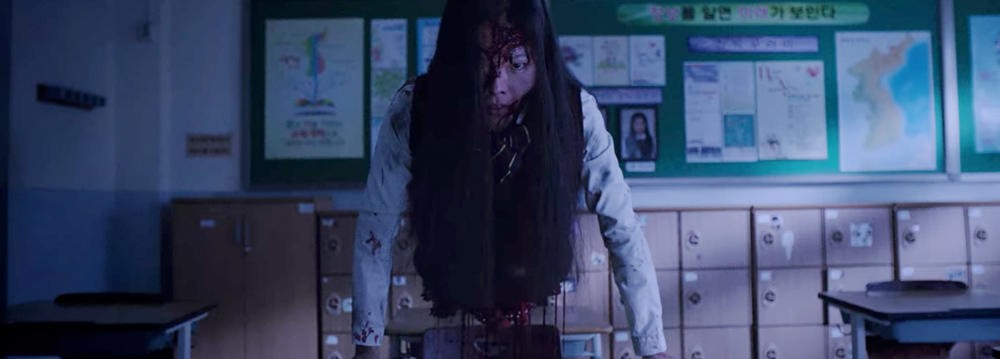Goedam: Hong Won-ki’s Netflix Series
Transnationalism and Ghostly Korean Urban Legends.
By Régis Olry.
A young girl in the restroom of her school realizes that there is no more toilet paper. Suddenly, she can hear a scary voice coming from nowhere and asking her, “Do you want blue or red paper?” This reference to a Korean urban legend is found in Gong Ji-young’s novel Bonsuni Eunni (봉순이 언니),1 which is the Japanese counterpart to a similar tale known as Aka Manto (Red Cape).2 Korean literature and cinema actually share some folk tales with surrounding countries: Many studies point out the links between Korean and Japanese urban legends on the one hand – the powerful symbolism of hair, for example3 – and renowned filmmakers on the other hand, like Miike Takashi and the late Kim Ki-duk, who unfortunately died of COVID-19 on December 11, 2020.4 Pivotal concepts developed across pan-Asian urban legends (e.g., school toilets, taxi drivers, mirrors, elevators, Ouija, and the internet) belong to what one Californian anthropologist refers to as “deep structure,” as opposed to locally adapted “superficial structure,” which is the diversity within historical content with respect to vernacular traditions.5
What Is an Urban Legend?
The American folklorist Jan Harold Brunvand defines urban legend as a “subclass of folk narratives (…) that – unlike fairy tales – are believed, or at least believable, and that – unlike myths – are set in the recent past and involve normal human beings rather than the ancient gods or demigods.”6 David Schaefer, who graduated in Japanese literature from Columbia University (New York), wrote a monograph in 1990 on Japanese urban legends and ascribed to them six main characteristics: They are “true,” primarily oral, short, linked together, unusually detailed, and cannot be traced to reliable witnesses.7 This last feature explains why a great many of these tales deliberately include spatial and/or temporal vagueness. For example, “once upon a time,” “long ago,” or “in a certain place” are the first words of many Korean,8 Japanese,9 Vietnamese,10 and Siamese11 tales.
Goedam
Hong Won-ki’s (홍원기) 2020 Netflix Series Goedam (괴담)12 (Figure 1), also known as Doshi Goedam (도시괴담), is an anthology of Korean ghost urban legends featuring eight short episodes (between 8 and 15 minutes each): “Crack” (틈), “Destination” (목적지), “Special Guest” (합방), “Curiosity”(장난), “Red Shoes”(맞춤신발), “Dimension”(엘리베이터), “Threshold” (문지방), and “Birth” (생일). As usual in Asian ghost movies,13 many actresses in Goedam are K-pop stars or top models: SeolA (Kim Hyeon-jeong) of the group Cosmic Girl and the model Lee Hyun-joo (former member of the group April) in Episode 4 serve as examples.

Let us go through some of these eight episodes.
The second episode (“Destination”) shows a young woman dressed all in white who takes a cab by night on a lonely road (Figure 2). But when she takes off her sunglasses, the taxi driver realizes that his passenger actually is a hollow-eyed ghost. This story refers to a Korean urban legend involving such a ghost seen in foggy weather, northwest of Seoul on the Jayuro Highway between Goyang and Paju. This kind of strange encounter by taxi drivers also occurs in Japan, especially near Midoro-ga-Ike Lake of Kyôto. In her 2016 Tohoku Gakuin University thesis, sociologist Yuka Kudo discovered that seven percent of Japanese taxi drivers claimed to have had at least one ghost as a passenger.14 The links between ghosts and cab drivers are also the core of the 2005 Thai movie Taxi Tonight.

Episode 4 (“Curiosity”) takes place in a high school. A girl is chased by a ghost after having found a creepy doll in her friend’s locker. Frightened, she hurtles down the stairs but always finds herself back on the same floor: She is trapped in a time loop (an implied reference to the impossible object known as the Penrose stairs). The same phenomenon occurs in the celebrated 2004 Thai movie Shutter, when photographer Tun runs away from his ex-girlfriend Natre, who became a vengeful ghost after having been raped by Tun’s friends. This episode also refers to another aspect of “deep structure” in urban legends: the spider-woman. Actually, the way the ghost crawls in the corridor and on the stairs (Figure 3) on the one hand, and the increase in the number of her pupils (most spiders have eight eyes) when she comes near her prey on the other hand, lead us to acknowledge this ghost as a Korean counterpart to the so-called Kumo Onna, the famous spider-woman of Japanese folklore.

In Episode 5 (“Red Shoes”), a bullied girl who had committed suicide (when her legs were crushed by a truck) comes back as a ghost in order to appropriate new legs. When she stands up on her hands, her teacher sees that the ghost, cut in two, has only its upper part left (Figure 4): She explains that Hye-su’s (another schoolgirl) legs were not correct and then encourages the ghost to take the teacher’s legs instead. This creepy creature also belongs to Japanese urban legends such as Teke Teke,15 the young Kashima Reiko who was cut in two by a train in Muroran, a coastal town in the south of Hokkaidô Island.

Goedam (including the soundtrack of its trailer) is a real masterpiece that will delight lovers of ghostly urban legends. Some viewers have pointed out the recurring lack of explanation: the uncertain status of the creepy doll in the locker of Episode 4, for example. But is not the lack of explanation precisely a sine qua non component of these kinds of legends?
References
1Gong J. (2018). Ma très chère grande sœur [French translation of Bonsuni eunni]. Arles, Philippe Picquier, p. 71.
2Devlin, T. A. (2018). Aka Manto. In Toshiden: Exploring Japanese urban legends (pp. 83–87). Independently published.
3Byrne, J. (2014). Wigs and rings: Cross-cultural exchange in the South Korean and Japanese horror film. Journal of Japanese and Korean Cinema, 6(2), 184–201.
4Rawle, S. (2009). From The Black Society to The Isle: Miike Takashi and Kim Ki-duk at the intersection of Asia Extreme. Journal of Japanese and Korean Cinema, 1(2): 167–184.
5Spiro, M. E. (1978). Burmese supernaturalism (p. xviii). Institute for the Study of Human Issues (Philadelphia, PA, USA).
6Brunvand, J. H. (1981). The vanishing hitchhiker: American urban legends and their meanings (p. 3). W. W. Norton.
7Schaefer, D. (1990). Urban legends and the Japanese tales (pp. 8–13). The Institute for Cultural Research (Tunbridge Wells, England).
8Carpenter, F. (1973). Cinderella. In Tales of a Korean grandmother (pp. 117–124). Tuttle.
9Mayer, F. H. (1984). Stepchildren stories. In Ancient tales in modern Japan: An anthology of Japanese folk tales (pp. 44–60). Indiana University Press.
Pham, D. K. (1989). Légendes des terres sereines (p. 7). Mercure de France.
10Le May, R. (1970). Siamese tales old and new (p. 123). Arthur Probstein.
11A 1968 ghost movie directed by Jeon Jo-Myeong had also been called Goedam.
12The Japanese top models Hashimoto Ai and Nakama Yukie in 2000 Ring 0: Birthday and 2012 Sadako 3D, respectively; the Japanese member of AKB48 13Matsubara Natsumi in 2012 Kotsutsubo; and the Taiwanese top model Shu Qi in 2004 The Eye 2, among many others.
14Kudo, Y. (2016). Yobisama sareru reisei no shinsagaku: 3.11 sei to shi no hazama de. Kadokawa Shoten.
15Devlin, T. A. (2018). Teke Teke. In Toshiden: Exploring Japanese urban legends (Vol. 1, pp. 35–39), Independently published; and Devlin, T. A. (2019). Sky resort. In Toshiden: Exploring Japanese urban legends (Vol. 2, pp. 23–24). Independently published.
The Author
Régis Olry, M.D. (France), is professor of anatomy at the University of Quebec at Trois-Rivieres (Canada). In the early 1990s, he worked in Germany with Gunther von Hagens, the inventor of plastination and the BodyWorld exhibitions. He currently studies the concept of Asian ghosts in collaboration with his wife who is a painter (see www.gedupont.com).







